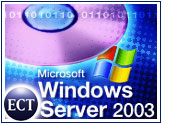
Windows is often the whipping boy when it comes to server platforms. But many in the industry now admit that Windows Server 2003 offers some significant breakthroughs over earlier versions of Microsoft’s server software — a change that could help Microsoft compete more effectively against Unix and Linux servers.
Windows Server 2003 is engineered with components that are based on the company’s new security strategies, such as having default installations automatically set to the highest level of security rather than the lowest. The company also has strengthened password security in the new software so that users cannot log on remotely using an account with a blank password.
In addition to this, Microsoft’s new Common Language Runtime software engine — one of the core components of the new server software — is, at least in theory, designed to help ensure a safer computing environment by reducing the number of bugs. The CLR is also the foundation upon which the Microsoft .NET strategy is built. It facilitates an execution environment that manages running code and provides services that make software development easier.
Incremental Changes
Dave Howard, president of development and consulting firm Colorado Software Architects, told TechNewsWorld that the latest improvements represent a collection of incremental changes rather than major breakthroughs. Howard also said that Microsoft’s claims about improvements to security need to be proven over time.
“Microsoft certainly has shown improved responsiveness in providing security updates for these problems,” he said. “It will take a continued display of responsiveness, coupled with proven reliability, to overcome some of the industry-wide concerns related to these security issues.”
Howard told TechNewsWorld that the manageability of security on Windows Server 2003 is easier now with Microsoft’s metadirectory services, which are designed to make it more straightforward to manage user identity metadata across multiple server environments.
“Perhaps the one item that comes closest to the breakthrough category is the recently announced pricing for the Small Business Server,” said Howard. “The new pricing is more than 50 percent less than the Windows 2000 Small Business Server, and its US$500 price point makes it a very attractive platform for small business users, [and it] certainly makes Linux pricing less of an issue.”
More Stable and More Secure
Christopher Faulkner, CEO of C I Host, based in Bedford, Texas, said that Windows 2003 is an “evolutionary upgrade that appears to be more stable and more secure.”
Faulkner told TechNewsWorld that one of the biggest differences between the new version and earlier versions of Microsoft’s server software is that the .NET framework no longer has to be downloaded separately. Rather, it is integrated into the operating system. Plus, he said, new technologies like WiFi, serial ATA and Gigabit Ethernet all can be managed more easily because of an improved management console.
“All of this makes the Windows 2003 Server much easier for administrators to operate and moves it closer to having an enterprise orientation,” said Faulkner. “That’s important for the small business market.” He also pointed out that Microsoft plans to keep up a steady stream of updates rather than go through the slower method of releasing major service packs only now and then.
Faulkner predicted that Microsoft is moving toward servers with more enterprise-level reliability. “They may be signaling with their stream of updates that they are going to attempt to move ahead with new technologies more swiftly and responsibly,” he said.
Clustering and Maintenance
Clustering services have become essential for organizations deploying critical e-commerce applications because they provide significant improvements in availability, scalability and manageability. In addition to the other incremental upgrades, Windows Server 2003 offers improved clustering support.
Windows Server 2003 supports server clusters for up to eight nodes. If one of the nodes in a cluster becomes unavailable because of failure or maintenance, another node begins providing service — a process known as failover. Windows Server 2003 also supports network load balancing (NLB), which balances incoming Internet traffic across nodes in a cluster.
While computing has proliferated on desktops, laptops and portable devices, the real cost of maintaining a distributed personal computer network has grown significantly. Reducing day-to-day maintenance through automation is key to reducing operating costs. Windows Server 2003 contains several important new automated management tools.
The new version of Windows Server is also designed to make managing group policy easier with the new Group Policy Management Console (GPMC), which is designed to enable more organizations to use the Active Directory service and take advantage of its management features.
XML and Web Services
Microsoft’s .NET technology, which enables software integration using XML Web services, is deeply integrated into Windows Server 2003. Integral to all of Microsoft’s technology these days, the .NET framework provides the ability to build, host and deploy systems that rely on XML Web services.
These XML Web services, according to proponents, can provide developers with much easier access to reusable Internet components built on industry standards. These components can call on the capabilities of other applications — independent of the way the applications were built, their operating system or platform, or the devices used to access them.
According to Microsoft, Windows Server 2003 was completely designed with Web services in mind. This technology — which essentially opens the door to federated collaboration — could have a significant impact on the industry, especially if more companies move to Microsoft software.
Microsoft Listening to Customers
John Gladding, senior solutions architect at Conchango, a consultant based in New York, told TechNewsWorld that Windows Server 2003 is “Microsoft’s best release by far, in terms of number of enhancements that will make for a more secure and manageable platform.”
However, he said, the new enhancements might not constitute a breakthrough so much as an indication that Microsoft clearly is listening to its customers. Like others, Gladding said that security and management options are some of the better refinements. But he added that there is still room for some improvements.
“One area where Microsoft still needs to improve is in better and simpler patch management,” he said. “Systems are being compromised by viruses that wouldn’t be an issue had an administrator applied all the released patches, which tells me that patch management isn’t quite there yet,” Gladding told TechNewsWorld.
“One might blame the administrator, but if the process for knowing about a patch, obtaining it, testing it and rolling it out [is] overwhelming, then Microsoft needs to share some of the blame,” he said, “although this shouldn’t be an issue for long, with all the work going into it now.”





















































Your article raises good points, but here’s a little story for you…
I have some Access database driven sites on a server running Windows Server 2003. These sites are now falling over regularly because (so the server techies have told me) the existing Access drivers cannot cope with the speed at which the requests are being generated.
Windows Server 2003 does offer marked improvements, agreed, but if certain other Microsoft produced items cannot cope with it, does it really help the end users all that much?
Cheers.
Some mistake in testing, with 5x advantage it should be leading all tpmc ratings by now (www.tpc.org). Hardly any presence in the benchmarks as of now.
We had reverse experience during one of our Websphere setup.
We did some performance testing of Oracle and a Java server application running on Red Hat Linux 9.0 and Win Server 2003 on identical hardware via dual-boot. We found that for most things, performance was comparable. However, in certain cases where it seemed the database and SCSI sub-system were being worked hard, Linux performed up to 5x faster! This was a dramatic and completely unexpected finding. Not surprisingly, we went on to choose Linux as our database and Java middleware platform.
We would suggest that anyone thinking of running an Oracle database server +/- a middleware server perform the same testing to find out for themselves if Linux or Win2003 gives better performance on identical hardware.